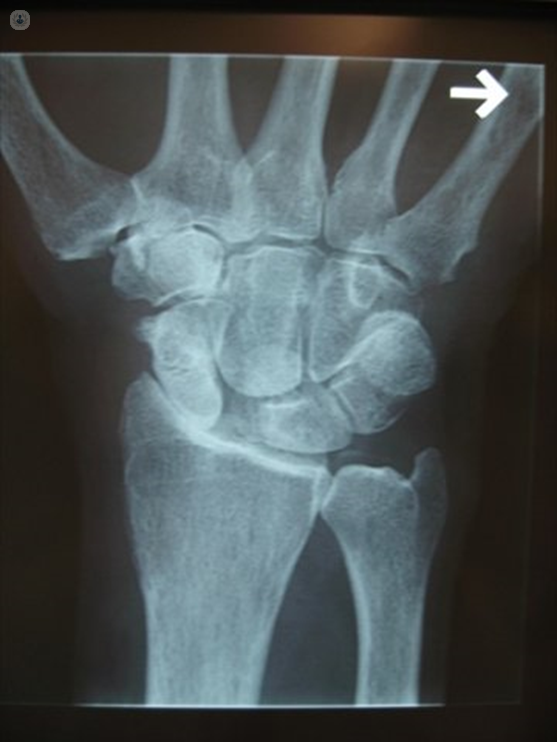How did I develop arthritis in my wrist?
Autore:Arthritis may seem simple, but it’s a complex condition and can develop in many ways. One of the most common types, osteoarthritis, often starts with age, but can also develop from a previous injury from many years ago. Mr James Nicholl, an orthopaedic surgeon based in Tunbridge Wells, explains how trauma can lead to arthritis and some ways we can manage this condition.

What is the difference between a sprained wrist and arthritis?
If somebody sprains their wrist then there’s usually a history of trauma to that wrist, or they’ve engaged in a vigorous activity which has caused the symptoms.
In arthritis, the pain and stiffness usually develop gradually with no definite precipitating cause. However, it’s not uncommon for a patient with wrist arthritis to only develop symptoms when they injure the wrist.
A high proportion of patients who come to me with painful arthritis in their wrist have evidence of a previous injury to the area, which may have been many years ago. When we look at x-rays of the wrist, there is often evidence that they tore the ligament between two bones in the wrist, called the scaphoid and lunate, or they fractured the scaphoid bone and it never properly healed. Over the years, painful arthritis then developed.
With an arthritic wrist, there may be an area of bony swelling, stiffness and reduced range of movement. After a sprain, there is more likely to be widespread, soft tissue swelling, possibly some bruising and movement may be limited by pain.
With a simple sprain, the symptoms should settle fairly rapidly, however, if this doesn’t happen, and the wrist remains painful, medical advice should be sought to ensure there is no underlying fracture or significant soft tissue injury.
Can some sports like cycling or golf cause wrist arthritis?
Performing any sport, including cycling or playing golf, will not cause arthritis but if somebody has arthritis in the wrist then doing sports may make the pain worse. For example, for cyclists where the wrist has to be bent backward and part of your weight supported using your hands, this may become difficult and painful as arthritis progresses.
If somebody has a sporting injury, for example, they fall off their bicycle onto their hand and cause a subtle fracture or ligament injury, then this may cause the wrist to become arthritic if left untreated.
What wrist exercises are there for arthritis?
In an arthritic joint, it is important to try and maintain as much movement and muscle strength as possible. If there is arthritis in the wrist, forcing too much movement may however make the pain worse. You should aim to maintain light movement by pushing the wrist back and forth, from side to side and also rotating the forearm. Strength can be maintained by squeezing a stress ball or piece of putty.
Will I have to wear a brace or wrist arthritis support?
The initial management for painful wrist arthritis is to try and control the symptoms by conservative means. This includes taking painkillers when required and wearing a wrist support can be beneficial.
Usually, I recommend a rigid splint which prevents the wrist from moving. This often helps with the discomfort but has to be balanced against the risk of the wrist becoming stiffer.
Often people with early arthritis in the wrist who want to continue playing sport, find a simple elasticated wrist support gives them some relief.
Can arthritis in the wrist be prevented?
The majority of patients who I see with painful osteoarthritis have developed this secondary to an injury which occurred some years ago. If the injury had been appropriately treated at the time, then this would have reduced the likelihood of arthritis developing. For example:
- Scaphoid fracture - if a patient has a scaphoid fracture that is not healing, then surgery to encourage the bone to heal can be performed.
- Torn ligament - if there is a torn ligament then repairing or reconstructing it should be considered.
- Fracture - if a patient has a fracture that damages the surface of the radius, or there is a fracture of the radius which is out of alignment, then this should be treated.
Treating all of these injuries at the time can prevent the subsequent development of arthritis.
Unfortunately, if arthritis develops spontaneously, and there is no history of trauma, then there is no way of preventing this from progressing. There are many supplements, such as glucosamine or turmeric which are popular, and various diets that are recommended. However, as far as I am aware, there is no strong evidence to suggest these can prevent arthritis either developing or progressing.
If you believe you suffer from any of the symptoms mentioned in this article, visit Mr James Nicholl’s profile and book an appointment to discuss them with him.



